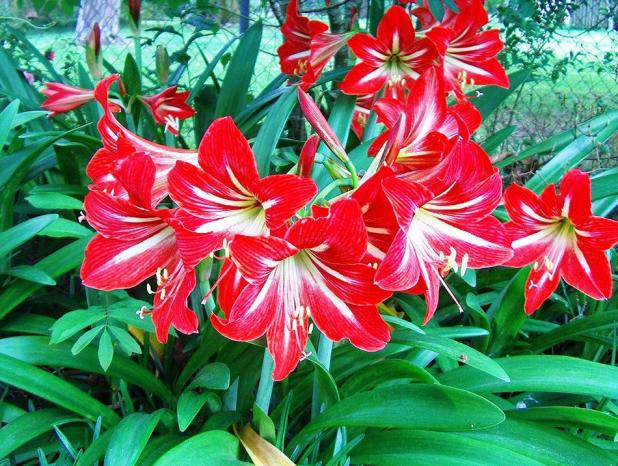
After they bloom indoors, you may plant amaryllis bulbs in the garden where they will make long-lived plants that bloom in spring. Amaryllis planted in the garden will get into their natural cycle and bloom in following springs.
—Allen Owings/LSU AgCenter file photo
Get It Growing: Amaryllis from houseplant to garden plant
Few flowering bulbs can surpass the stately beauty of the amaryllis. Typically blooming in April, this popular bulb is a star performer in the spring garden. Dormant bulbs are readily available now, and with proper care, they can become a long-lasting part of your landscape.
Amaryllis plants belong to the genus Hippeastrum, and those we grow today are mostly hybrids of several species. We really are fortunate to be able to grow these natives of South America and South Africa in garden beds. In colder regions, amaryllis must be grown in containers because they would freeze during winter if planted in the ground.
Dormant bulbs that you purchase now, however, must be handled specially this winter. When they are dried and forced into dormancy for shipping purposes, the bulbs are triggered to bloom during winter rather than spring. If you plant bulbs you purchase now outside into the garden, they will send up their flower stalks this winter when they are likely to be damaged by cold.
Caring for Amaryllis Indoors
Amaryllis bulbs purchased now should be planted into pots using a well-drained potting soil with the top quarter of the bulb above the soil surface. (You can also buy them already potted.) The pot should be large enough for a 1-inch clearance between the pot rim and the bulb.
Clay or plastic pots may be used, but because an amaryllis in bloom can be somewhat top-heavy, clay pots provide a little more stability.
Place the pot in a sunny window (the more sun the better) and keep the soil evenly moist. When the flower stalk begins to emerge, rotate the pot one-half turn every few days so it will grow straight. Otherwise, it will grow towards the window and look awkward. If you provide your amaryllis with too little light, the flower stalk will grow excessively tall and may even fall over.
Flowering generally occurs in December or early January from bulbs planted now. Some large bulbs will produce two flower stalks.
Sometime after the flower spike has emerged, leaves will grow from the top of the bulb. After the flowers have faded, cut the stalk at the point where it emerges from the bulb, but do not cut any foliage. Keep the plant inside and continue to provide plenty of light or the leaves will be weak and floppy.
You should water regularly when the soil begins to feel dry, but it is not really necessary to fertilize your amaryllis during this time.
Plant your bulbs into the garden when April arrives. Amaryllises planted in the garden in spring will get into their natural cycle and bloom in April the following years.
Caring for Amaryllis in Garden Beds
If you are growing amaryllis in your garden now, you know just how care free they are. They thrive in any reasonably good garden soil as long as drainage is good. A spot that receives part sun (about six hours of direct sun and then shade in the afternoon) is the ideal location, but I have seen amaryllis thrive in full sun to part shade.
Once planted and established, amaryllis can be left alone for many years. A light sprinkling of general-purpose fertilizer in March and June and watering during unusually dry weather is all they need. Beds should be mulched with about 2 inches of pine straw, leaves or other similar material to help reduce weeds and conserve moisture. Increase the thickness of the mulch to 3 or 4 inches during winter to help protect the bulbs from freeze damage.
Although it is not necessary to dig and store amaryllis bulbs in the fall each year, clumps of bulbs can become overcrowded, and fall is a good time to divide them. If needed, divide your amaryllis now by lifting the clumps of bulbs carefully so as not to damage them in the process.
Try to retain of the roots attached to the bulbs. I like to use a garden fork because it will not cut through the roots. Separate smaller bulbs from the larger bulbs and put them in two piles. Trim off any yellow or unhealthy foliage, but leave healthy, green foliage attached.
While the bulbs are out of the bed, take the opportunity to turn the soil and incorporate some compost, rotted manure or peat moss to enrich the soil.
Replant the largest bulbs immediately back into their area until it is filled. Amaryllis bulbs are planted with the narrow top of the bulb, or “neck,” exposed above the soil surface. Do not plant the bulbs too deep, or flowering will decrease.
Bulbs are generally spaced about 8 inches apart and show best in the garden when planted in clumps of three or more. Mulch the bed to provide cold protection for the bulbs this winter.
The smaller bulbs can be planted into another area where you want amaryllis or given to friends. Some may bloom next spring or not until later years, depending on their size. This is the most common method of propagating amaryllis.
